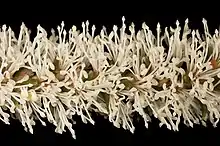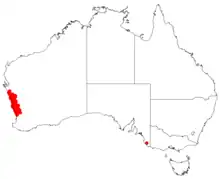| Ribbed hakea | |
|---|---|
 | |
| Hakea costata | |
| Scientific classification | |
| Kingdom: | Plantae |
| Clade: | Tracheophytes |
| Clade: | Angiosperms |
| Clade: | Eudicots |
| Order: | Proteales |
| Family: | Proteaceae |
| Genus: | Hakea |
| Species: | H. costata |
| Binomial name | |
| Hakea costata | |
 | |
| Occurrence data from AVH | |
Hakea costata, commonly known as the ribbed hakea,[1] is a shrub in the family Proteaceae native to Western Australia. A multi-stemmed small shrub producing attractive pink or white brush-like blooms rich in nectar from July to October.
Description
Hakea costata is an erect non-lignotuberous shrub growing to 0.3 to 2 metres (1.0 to 6.6 ft) high. The smaller branches are densely covered in long soft straight hairs when flowering. Leaves vary depending on where they appear on the shrub. Near the flowers the leaves are mostly linear, rigid and triangular in cross-section 8 to 16 mm (0.315 to 0.630 in) long and 1 to 2.5 mm (0.039 to 0.098 in) wide. The leaves below flowers are flat, narrowly egg-shaped to oval shaped 2 to 5 millimetres (0.079 to 0.197 in) wide. The leaves upper surface have no obvious veins whereas the underside has a prominent mid-vein. The inflorescence has 8-12 strongly scented white or pink flowers in racemes 8–16 cm (3–6 in) long appearing in leaf axils from July to October. The perianth is cream-white, pistil 6 to 9 mm (0.236 to 0.354 in) long. The small fruit are attached to the stem without a stalk, more or less egg-shaped 09–1 cm (3.543–0.394 in) long and 0.6–0.8 mm (0.024–0.031 in) wide slightly curved ending with a short beak. The fruit surface is smooth to slightly warty. The black-brown seeds are more or less elliptic shaped with a wide wing down one side and a narrower wing down the other.[2][3][4][5]
Taxonomy and naming
Hakea costata was first formally described by the botanist Carl Meissner in 1845 and published in Johann Georg Christian Lehmann's book Plantae Preissianae.[6][7] The specific epithet is derived from the Latin (costatus) meaning "ribbed",[8] referring to the longitudinal ribbing of the leaves.[2]
Distribution
Ribbed hakea is endemic to an area along the west coast in the Wheatbelt and Mid West regions of Western Australia from about Kalbarri in the north to Yanchep in the south growing in sandy soils over limestone or laterite.[2][9]
References
- 1 2 "Hakea costata". APNI. Retrieved 25 January 2019.
- 1 2 3 "Hakea costata". Electronic flora of South Australia. Government of South Australia. Retrieved 12 October 2018.
- ↑ Young, J A (2006). "Hakeas of Western Australia:A Field and Identification Guide". J A Young. ISBN 0-9585778-2-X.
- ↑ Holliday, Ivan (2005). "Hakeas a Field and Garden Guide". Reed New Holland. ISBN 1-877069-14-0.
- ↑ Barker, Robyn M.; Haegi, Laurence A.; Barker, William R. (1999). Wilson, Annette (ed.). Flora of Australia (Volume 17B, Proteaceae 3, Hakea to Dryandra) (PDF). Canberra / Melbourne: ABRS / CSIRO. pp. 145–146. Retrieved 27 January 2019.
- ↑ "Hakea costata Meisn". Atlas of Living Australia. Global Biodiversity Information Facility. Retrieved 12 October 2018.
- ↑ Meisner, Carl (1845). "Hakea costata". Plantae Preissianae: 580. Retrieved 28 January 2019.
- ↑ Brown, Roland Wilbur (1956). The Composition of Scientific Words. Washington, D.C.: Smithsonian Institution Press. p. 232.
- ↑ "Hakea costata". FloraBase. Western Australian Government Department of Biodiversity, Conservation and Attractions.